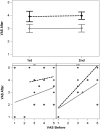Clown-care reduces pain in children with cerebral palsy undergoing recurrent botulinum toxin injections- A quasi-randomized controlled crossover study
- PMID: 28414728
- PMCID: PMC5393564
- DOI: 10.1371/journal.pone.0175028
Clown-care reduces pain in children with cerebral palsy undergoing recurrent botulinum toxin injections- A quasi-randomized controlled crossover study
Abstract
Objective: We investigated the impact of clown-care on pain in 45 children with cerebral palsy who underwent recurrent Botulinum-toxin injections (age 7.04± 4.68 years). Participants were randomized to receive either clown (n = 20) or standard (n = 25) -care.
Methods: Pain Visual-Analogue-Scale (range 1-5) was reported before and after procedures. Pain assessment was lower for children undergoing Botulinum-toxin injections with clown-care (2.89± 1.36) compared to standard-care (3.85± 1.39; p = 0.036) even though pain anticipated prior to procedures was similar (~3).
Findings: Children who underwent the first procedure with clown-care reported lower pain even after they crossed-over to the following procedure which was standard (p = 0.048). Carryover effect was more prominent in injection-naïve children (p = 0.019) and during multiple procedures (p = 0.009). Prior pain experience correlated with pain in subsequent procedures only when first experience was standard-care (p = 0.001).
Conclusions: Clown-care alleviated pain sensation during Botulinum-toxin injections and initial clown-care experience reduced pain during subsequent injections even though clowns were not present.
Trial registration: clinicaltrials.gov ID # NCT01377883.
Conflict of interest statement
Figures





References
-
- Hagberg B, Hagberg G, Olow I, von Wendt L. The changing panorama of cerebral palsy in Sweden. VII. Prevalence and origin in the birth year period 1987–90. Acta Paediatr. 1996;85(8):954–60. - PubMed
-
- Engel JM, Petrina TJ, Dudgeon BJ, McKearnan KA. Cerebral palsy and chronic pain: a descriptive study of children and adolescents. Phys Occup Ther Pediatr. 2005;25(4):73–84. - PubMed
-
- Sanger TD. Hypertonia in children: how and when to treat. Curr Treat Options Neurol. 2005;7(6):427–39. - PubMed
Publication types
MeSH terms
Substances
Associated data
LinkOut - more resources
Full Text Sources
Other Literature Sources
Medical

